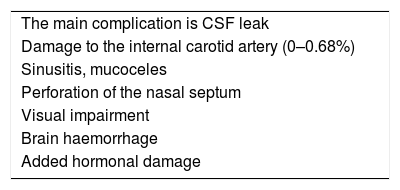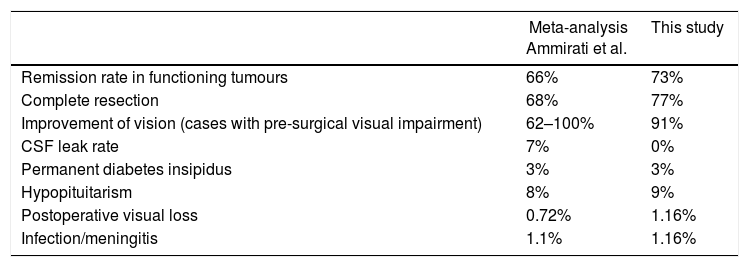The endoscopic endonasal approach has become the gold standard for the surgical treatment of pituitary adenomas.
ObjectivesThe aim of this study is to present the results obtained in our hospital in purely endoscopic surgery of pituitary adenomas.
MethodsFrom February 2011 to August 2016, we conducted a prospective study on a series of 86 patients with pituitary adenoma, all of whom underwent surgery with a purely endoscopic endonasal approach. The ‘four hands-two nostrils’ technique was performed in all cases by a surgical team composed of an ENT surgeon and a neurosurgeon. Mean follow-up was 32 months. All patients were evaluated according to clinical, radiological and endocrinological criteria.
ResultsIn our series, 53% were women and 47% men. The age ranged from 14 to 84 years of age, with a mean of 54 years of age. The most common initial symptom was visual deficit (42%), followed by hormonal hyperfunction (21%), with acromegaly being the most common clinical syndrome. The most common tumours were non-functioning tumours (73%), while GH-secreting tumours (65%) were the most common functioning adenoma. Regarding tumour size, 76% were macroadenomas, 11% microadenomas and 13% giant adenomas. Approximately 63% of the adenomas exhibited suprasellar extension and 37% involved invasion of the cavernous sinus (Knosp grade ≥3). Total excision was achieved in 77% of the cases. After the intervention, visual improvement was achieved in 91% and remission of endocrine hyperfunction in up to a 73% of cases. The most common complication was anterior pituitary insufficiency of at least one axis (9%). There were no cases of postoperative cerebrospinal fluid fistula.
ConclusionsIn terms of surgical quality, our results are similar to those of published series, and demonstrate the efficacy and safety of the endoscopic endonasal approach as the surgical treatment of choice for pituitary adenomas. However, further studies with a higher sample size are necessary to obtain clinically significant results.
El abordaje endoscópico endonasal se ha convertido en la técnica quirúrgica de elección para el tratamiento de los adenomas hipofisarios.
ObjetivosEl objetivo de este trabajo es presentar los resultados obtenidos en nuestro hospital en cirugía puramente endoscópica de los adenomas hipofisarios.
MétodosHemos realizado un estudio prospectivo, recogiendo a los pacientes intervenidos de adenoma hipofisario mediante un abordaje endonasal puramente endoscópico, desde febrero de 2011 hasta agosto de 2016, obteniendo una muestra total de 86 pacientes. Todos los pacientes fueron intervenidos conjuntamente por un ORL y un neurocirujano con la técnica de four hands-two nostrils. El seguimiento medio postoperatorio fue de 32 meses. Todos los pacientes fueron evaluados según criterios clínicos, radiológicos y endocrinológicos.
ResultadosEn nuestra serie un 53% eran mujeres y un 47% hombres; el rango de edad variaba desde los 14 hasta los 84 años, siendo la media de 54 años. El síntoma inicial más habitual fue el déficit visual (42%), seguido por la hiperfunción hormonal (21%), siendo la acromegalia el síndrome clínico observado con más frecuencia. Los tumores más frecuentes fueron los no funcionantes (73%), y de entre los adenomas funcionantes el más frecuente fue el productor de GH (65%). En cuanto a tamaño tumoral, un 76% eran macroadenomas, un 11% microadenomas y un 13% gigantes. Un 63% presentaban extensión supraselar y un 37% invasión de seno cavernoso (grado de Knosp ≥3). Se consiguió una exéresis total en un 77% de los casos. Tras la intervención se consiguió en un 91% mejoría visual y hasta en un 73% remisión de la hiperfunción endocrina. En cuanto a las complicaciones, la más frecuente fue la insuficiencia de al menos un eje de la hipófisis anterior (9%), sin presentar casos de fístula de LCR posquirúrgica.
ConclusionesNuestros resultados, en términos de calidad quirúrgica, se asemejan a las series publicadas y avalan la eficacia y seguridad del abordaje endoscópico endonasal como técnica de elección en el manejo quirúrgico de la glándula hipofisaria. Sin embargo, es necesario un estudio con mayor número de casos para obtener resultados con significación clínica.
Article

If it is the first time you have accessed you can obtain your credentials by contacting Elsevier Spain in suscripciones@elsevier.com or by calling our Customer Service at902 88 87 40 if you are calling from Spain or at +34 932 418 800 (from 9 to 18h., GMT + 1) if you are calling outside of Spain.
If you already have your login data, please click here .
If you have forgotten your password you can you can recover it by clicking here and selecting the option ¿I have forgotten my password¿.














